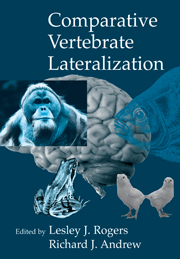Book contents
- Frontmatter
- Contents
- List of Contributors
- Preface
- Introduction
- Part one Evolution of lateralization
- Part two Development of lateralization
- 5 Behavioural development and lateralization
- 6 Factors affecting the development of lateralization in chicks
- 7 Ontogeny of visual asymmetry in pigeons
- 8 Development of laterality and the role of the corpus callosum in rodents and humans
- 9 Posture and laterality in human and non-human primates: Asymmetries in maternal handling and the infant's early motor asymmetries
- Part three Cognition and lateralization
- Part four Lateralization and memory
- Epilogue
- Author Index
- Subject Index
- Richard Andrew
9 - Posture and laterality in human and non-human primates: Asymmetries in maternal handling and the infant's early motor asymmetries
Published online by Cambridge University Press: 10 December 2009
- Frontmatter
- Contents
- List of Contributors
- Preface
- Introduction
- Part one Evolution of lateralization
- Part two Development of lateralization
- 5 Behavioural development and lateralization
- 6 Factors affecting the development of lateralization in chicks
- 7 Ontogeny of visual asymmetry in pigeons
- 8 Development of laterality and the role of the corpus callosum in rodents and humans
- 9 Posture and laterality in human and non-human primates: Asymmetries in maternal handling and the infant's early motor asymmetries
- Part three Cognition and lateralization
- Part four Lateralization and memory
- Epilogue
- Author Index
- Subject Index
- Richard Andrew
Summary
Introduction
This chapter is concerned with the question of the relations and possible influences of environmental factors on the establishment of patterns of manual lateralization in human and non-human primates. More specifically, we are interested in the relation between maternal postures and laterality in nonhuman primates (e.g. bias in cradling behaviour and hand preference of the mother) and the development of patterns of manual preferences in infants. In order to understand fully the many ways in which these variables could interact, we first review the evidence of postural biases in human adults when cradling and carrying their offspring. Next, we examine the divergent hypotheses advanced to explain the observed biases. The same is then done for non-human primates. A second part of our chapter (see Section 9.3) describes the different asymmetric patterns observed during the development of the infant concerning head turning, nipple preference, etc. in both human and non-human primates.
In a third part (see Section 9.4), we describe and compare the methods and definitions used by the different authors in their work. Then, we present the descriptions and definitions of behaviours that we are using in an ongoing study of Olive baboons (Papio anubis).
Our main goal is to contribute to understanding the phylogenetic origins of hand laterality in humans by examining some of its possible determinants in non-human primates.
- Type
- Chapter
- Information
- Comparative Vertebrate Lateralization , pp. 306 - 362Publisher: Cambridge University PressPrint publication year: 2002
- 21
- Cited by



